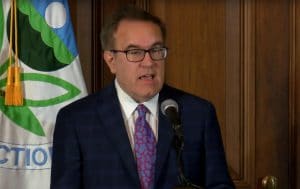The Trump administration inched closer to setting lower fuel economy and emissions rules that those mandated by the previous administration after the agencies reviewing the standards sent their final recommendations to the White House.
The process has been ongoing for the past 17 months with only a promise by President Donald Trump that the final numbers will be lower than those of the Obama administration.
The Environmental Protection Agency and National Highway Traffic Safety Administration submitted their proposals for 2021 through 2026 model year fuel efficiency to the White House Office of Management and Budget, the agencies noted.
(California moves to block Trump fuel efficiency standard)

California Attorney General Xavier Becerra has made good on his threat of “Mr. President, we’ll see you in court.”
The final rules are expected to be in place in March or April, Reuters reported.
In August 2018, the Trump administration suggested freezing fuel efficiency standards at 2020 levels until 2026, which is much easier than the tougher standards President Barack Obama implemented during the end of his tenure. The final rules will be somewhere in between, officials have suggested.
“We’re not going to be flat, as was proposed,” Acting NHTSA Administrator James Owens told Reuters in a recent interview. “We’re going to set standards that are reasonable and achievable.”
(Trump confirms mileage standards cut, elimination of California clean air waiver)
According to several automakers the new Trump rules are expected to require annual fuel efficiency gains of about 1.5%, which is significantly lower than the 5% improvements demanded by the Obama era rules. However, there are other significant changes designed to make it less demanding for automakers.

EPA Admin Andrew Wheeler, a former coal-industry lobbyist, believes the proposed changes will save money and lives.
EPA says the final rules “will benefit all Americans by improving the U.S. fleet’s fuel economy, reducing air pollution, and making new vehicles more affordable for all Americans.” Rolling back the regulations has cause a major firestorm between the administration and several states, led by California, as well as environmental groups.
The administration believes that the rollbacks are necessary for economic and safety reasons; however, California and environmentalists claim the analysis is flawed and instead would raise costs to consumers in the form of more money spent on fuel.
(Trump Admin Eliminates CA Waiver, Delays Details on Fuel Economy Roll Back)
The administration’s 2018 proposal would have resulted in average fuel efficiency of 37 miles per gallon (mpg) by 2026, compared with 46.7 mpg under rules adopted in 2012. The Trump administration’s “preferred option” would have hiked U.S. oil consumption by about 500,000 barrels per day by the 2030s but reduced automakers’ regulatory costs by more than $300 billion, Reuters reported.

